
LURES and STREAMERS
BACK TO TABLE OF CONTENTS
Lures - and streamers are included under this heading - are designed primarily to imitate baitfish. They can also act as attractors, when their bright flashy appearance and movement is what makes them so successful. Lures are primarily associated with autumn fishing, when the fish have turned to fry feeding to fatten up for the winter. Lures are also used extensively in salmon fishing and sea fishing to act as both an attractor and an imitator.
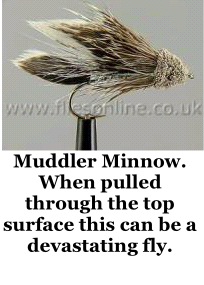 Lures can be designed to be fished at all depths, from the Muddler Minnow fished on the surface as part of a dry fly team to the huge tubes and tandems fished for salmon, lake trout and browns lurking in the deeps.
Lures can be designed to be fished at all depths, from the Muddler Minnow fished on the surface as part of a dry fly team to the huge tubes and tandems fished for salmon, lake trout and browns lurking in the deeps.
Our ubiquitous booby can be included in this category but, as mentioned before, the buoyant nature of this fly means that it is fished in its own inimitable style. Only the booby and razzler family of buoyant flies are fished by allowing the line to sink completely to the bottom before retrieval. It is worth noting that this fly has been so deadly that some venues have banned it - so it is worth asking when arriving at a new location whether it is permitted before using it.
The size of a lure can vary from the small ones permitted in competition fishing - sometimes called mini-lures - to the tubes and tandems which can be over six inches in length. Remember the size limit on flies in a competition or you'll be disqualified before you start. Usually the maximum size is around one inch - but check for your particular event.
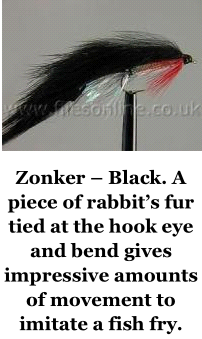 Subtlety is not a strong suit when fishing a lure as a baitfish imitation. You wouldn't hang around if you were being chased by something that wanted you for dinner! So the idea is to find an area where the trout are feeding on fry and pull your lure through the melee. Look for fry jumping or the swirls as the trout crash through the shoal just below the surface. This is most likely to be in a shallow area such as a bay or an area where the fry might seek shelter, like a jetty - but don't fish next to the boat jetty if it is in use!
Subtlety is not a strong suit when fishing a lure as a baitfish imitation. You wouldn't hang around if you were being chased by something that wanted you for dinner! So the idea is to find an area where the trout are feeding on fry and pull your lure through the melee. Look for fry jumping or the swirls as the trout crash through the shoal just below the surface. This is most likely to be in a shallow area such as a bay or an area where the fry might seek shelter, like a jetty - but don't fish next to the boat jetty if it is in use!
While long pulls on the line works as a method of retrieval, I have had better results by casting out, tucking the rod under my arm and then retrieving in a hand over hand method to keep the lure in constant motion. When a fish takes the fly just keep retrieving to drive the hook home before reverting to the normal hold to play the fish. Alternatively, cast the fly out and retrieve it with short sharp jerks as if the fry was injured and again this should be done at a good speed.
The technique of tucking the rod under your armpit and giving long pulls works well with the zonker type of lure. These are essentially strips of rabbit fur tied along the shank of a long shanked hook. The fur undulates invitingly as it is pulled through the water. One potential drawback of this lure is that a portion of the strip of fur protrudes beyond the bend of the hook. This has a tendency to wrap itself around the bend of the hook during casting. This can be very frustrating because the fault will not be noticed until you have pulled the pure back – and no fish is going to be interested in a lump of fur with no wiggle factor! The answer to this problem is to put just a tiny drop of superglue on the skin of the protruding strip, avoiding contact with the fur. This will dry and stiffen the skin, thereby overcoming its tendency to twist during casting.
I once caught two double figure trout in consecutive casts with this jerked retrieve. I let the cats whisker fall nearly to the bottom in thirty feet of water before starting my retrieve along the edge of a fish cage that was known to attract monsters. You may not have a fish cage on your water - and sadly they are gone from the water I frequented - but there are still natural holding points where this technique will be effective.
Also included in this category are the tube flies. These are a specialist creation for fishing for salmon where a big fly is needed. The fly is actually tied onto a metal or plastic tube, which is then slipped over the leader and the hook - usually a treble is tied on to keep the tube in place. From this description you can appreciate that in a tube fly the hook is not an integral part of the fly. Because the tube is separate to the hook it is possible to tie much longer flies as you are not limited by the length of the hook shank. Some tubes flies can be as much as six inches long to tempt monster salmon that can run over 50 lb.
Another speciality format for the salmon enthusiast is the Waddington, which is tied with a treble hook which is jointed at the shank, but is essentially the same as a tube. Many salmon flies are tied to double or treble hooks to counteract the hard mouth of a salmon. A single hook would be much more likely to slip at the critical strike.
A final format for large prey fishing is the tandem. In this system two flies are tied, either identically or to complement each other. A heavy weight piece of monofilament is tied to the shank of the first hook and then attached to the eye of the second hook, thereby creating a two hook system which gives extra length and interest to the fly.
Many and varied ways have been devised to create a fry imitation, but all are intended to be fished at reasonable speed to provoke the chase instinct inherent in all game fish. I had many occasions while lure fishing for trout when there would be a huge thump on the line which resulted in no fish. This was put down to the fish not getting hold of the fly properly. But I found that, quite often, I would catch a fish that was actually hooked in its cheek or even its gill plate. I came up with the idea that the fish side swipe the lure just as it might when crashing through a shoal of fry. The side swipe was what results in the big thump. This idea is given credibility by the underwater videos of big game fish such as sailfish attacking shoals of sardine. They are seen to herd the fish into a bait ball and then sideswipe it with their bills, vacuuming up the fish that have been stunned.
With a single hook it is less likely that the hook would have a chance to get a firm hold when being hit in this way. Ever the experimenter, I came up with the idea that you might have a better chance of converting these side swipes into fish in the bag by using a slightly different method of lure construction. Instead of making up your fly with a normal forged hook try using a double hook. These are hooks forged so that two hooks share one shank. The angle between each hook is about 45 degrees and gives a much wider area of hooking coverage. They are sometimes known by the name of wee doubles. This simple change resulted in bigger fish being caught and fewer thumps coming to nothing. Don't be afraid to try tying these flies yourself - they are much easier than you think. Look in the section on fly construction and follow the ideas for tying a leech pattern.
You could, of course, take the idea one step further and use a treble hook, but I found they didn't seem to move as well through the water. The construction of a double hook tends to give the lure a natural balance with the two hooks acting as stabilisers, whereas a treble hook has more of a tendency to spin. One word of warning - some waters only permit the use of one hook on your line and these constructions would count as two or three hooks and would be illegal on that water. As ever, ask to be on the safe side.
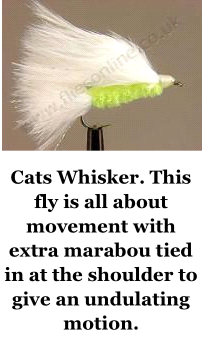 Lures are all about movement, not just speed through the water but also action created by the material used in the fly itself. The perfect example of this idea is the cat's whisker. This fly is tied with a marabou tail and a similar bunch of marabou tied just behind the hook eye. This extra marabou undulates along the back of the fly as it is pulled through the water, and this action is repeated by the tail of the fly. This gives a lure that is all movement, from the front of the hook to the tip of the tail. You might want to try making up a closed cell foam imitation fry. Just cut the shape of a small fish out of a plastazote block. Whip a line of thread down the shank of a long hook and then push the hook through the body of the foam fish so that the eye sits at the head of the fish. Finally a drop of superglue will hold everything in place. This fly is then fished on a floating line - in contradiction to all other lure fishing methods. Here the idea is to cast your floating fry pattern out where the trout are attacking a shoal of small fish and then twitch it back in a series of sharp jerks. The trout will assume this is one of the fry that has been side-swiped and has an injured swim bladder. Unable to submerge, the fry is apparently thrashing around on the surface and presents an ideal target for the feeding trout. Takes are very splashy and can be great sport when the circumstances are right.
Lures are all about movement, not just speed through the water but also action created by the material used in the fly itself. The perfect example of this idea is the cat's whisker. This fly is tied with a marabou tail and a similar bunch of marabou tied just behind the hook eye. This extra marabou undulates along the back of the fly as it is pulled through the water, and this action is repeated by the tail of the fly. This gives a lure that is all movement, from the front of the hook to the tip of the tail. You might want to try making up a closed cell foam imitation fry. Just cut the shape of a small fish out of a plastazote block. Whip a line of thread down the shank of a long hook and then push the hook through the body of the foam fish so that the eye sits at the head of the fish. Finally a drop of superglue will hold everything in place. This fly is then fished on a floating line - in contradiction to all other lure fishing methods. Here the idea is to cast your floating fry pattern out where the trout are attacking a shoal of small fish and then twitch it back in a series of sharp jerks. The trout will assume this is one of the fry that has been side-swiped and has an injured swim bladder. Unable to submerge, the fry is apparently thrashing around on the surface and presents an ideal target for the feeding trout. Takes are very splashy and can be great sport when the circumstances are right.
Lures are also made to emulate other creatures. The obvious examples are the large orange and pink creations made up to imitate shrimp and similar shellfish. These are used in both salmon fishing and in saltwater fishing. I have seen exotic creations made in coloured deer hair tied up to look like frogs and even water animals such as voles. The only limitation is the extent of your imagination!
In this video Dave shows how to tie up a Baby Doll - so to speak!

While not strictly a lure, The Egg Fly imitates the eggs spilt by a spawning salmon, which the trout will greedily vacuum up. I used this fly when I lived in Canada in the early eighties and it has now found its way to this country. Here Dave shows how it’s tied.

This video shows Dave building a Woolly Bugger which is a well known and effective lure.
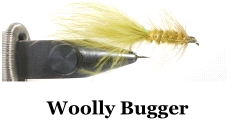
Another lure, this one called the Humungus.

This lure is called the Yellow Dancer and includes a generous palmer along the body.
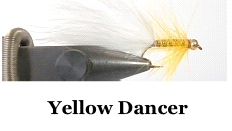
And this is the Texas Rose Muddler which introduces the art of spinning a deer hair head.
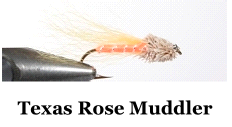
The Minkie is a progression from the Zonker but, as its name implies it is tied with mink rather than rabbit’s fur. The mink is a much finer fur than rabbit and imparts more motion to the fly. Mink can be expensive unless you can find an old ladies coat in the used clothing store!
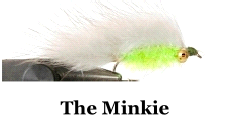
No box of lures is complete without a cat’s whisker. The additional marabou tied in as a wing gives great movement for this fry imitation. Although the standard body is fluorescent green chenille there is no reason why you cannot experiment with colour and texture.
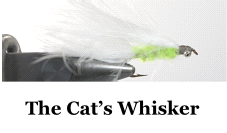
The Blob has become popular over recent years and, while it is impossible to even suggest that this fly matches anything in the animal kingdom, it is a real killer. Fished static, stripped, on a sinker or floater this really is a fly for all seasons!
A favoured way of fishing this fly is to set up a slow sink line (1 or 2 inches per second) with three blobs set about four feet apart, making a total leader length of twelve feet. The point fly is actually a FAB, which is a blob with a piece of plastazote foam tied in at the bend (I’m told the FAB stands for “foam assed blob!). Equally, you could use a booby blob at the point which serves the same purpose - and that is to create a commotion when it lands in the water, and you immediately strip it back several feet causing a splash and wake in the water before the line pulls it under. This disturbance attracts any nearby fish who will come to investigate, thus “discovering” your flies. Continue drawing the line back at a medium speed. It’s a great way to fish when you suspect trout near the surface and great fun to see the wake of a fish arrowing in towards your flies!
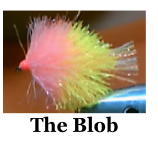
Here are two videos I made fishing blobs in very shallow water – I could see the fishing in just a couple of feet of water!